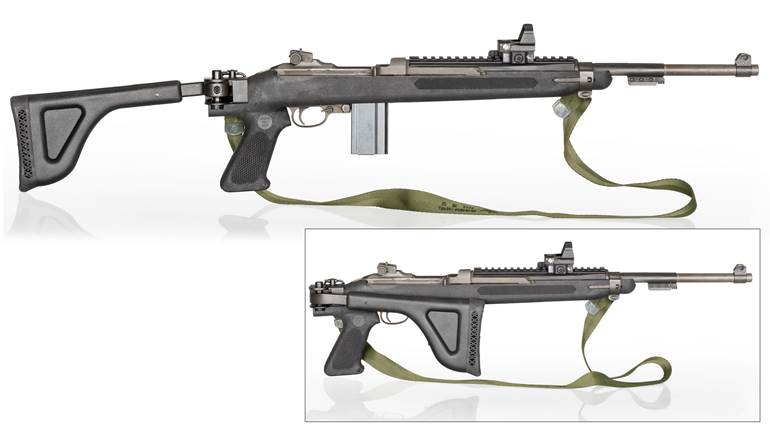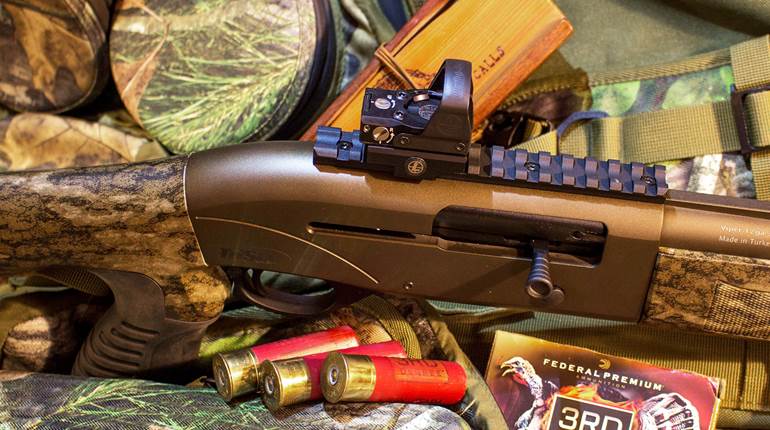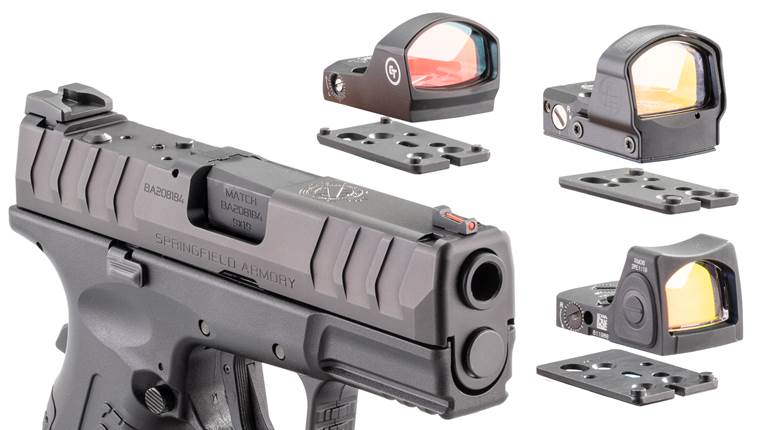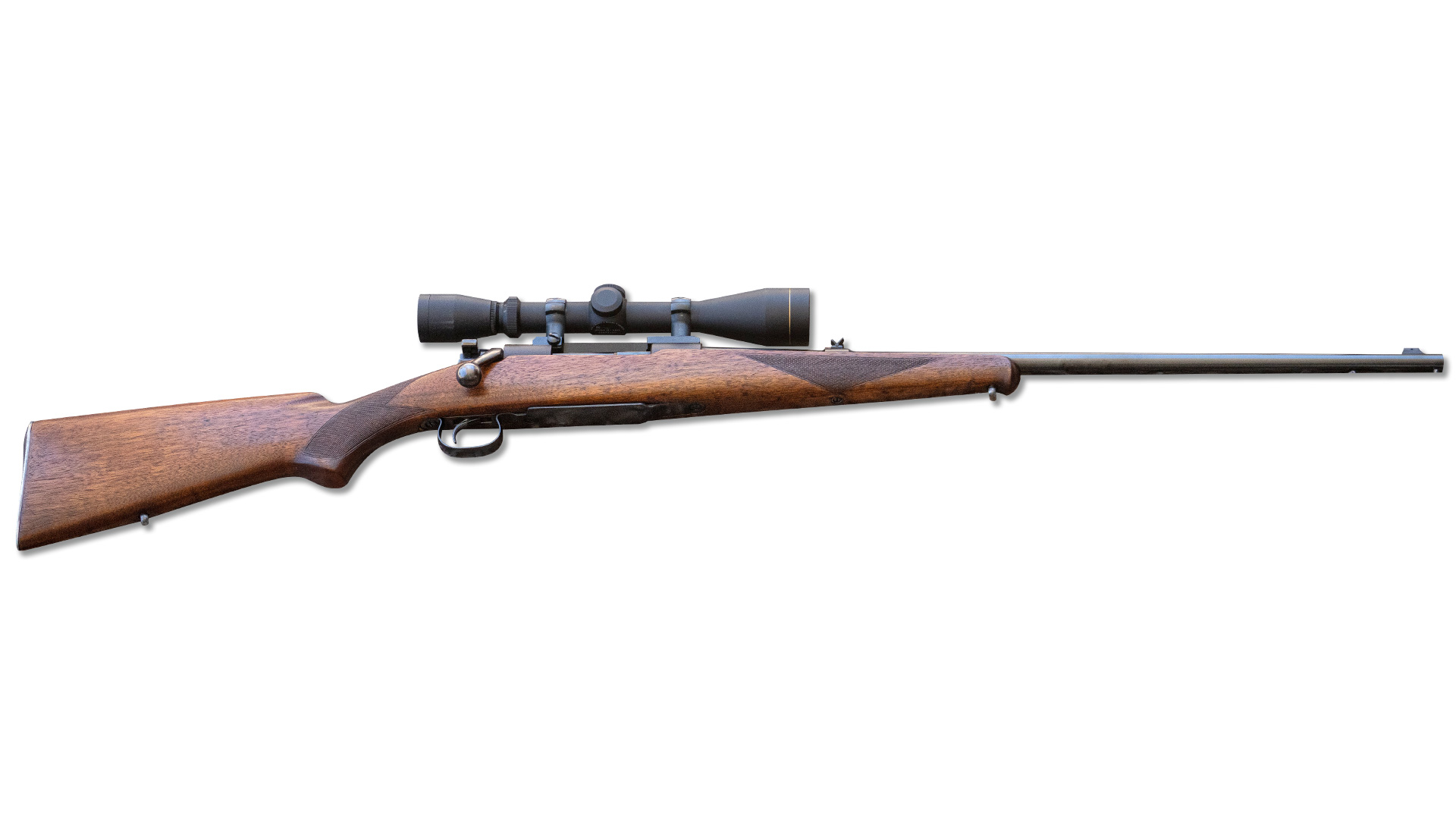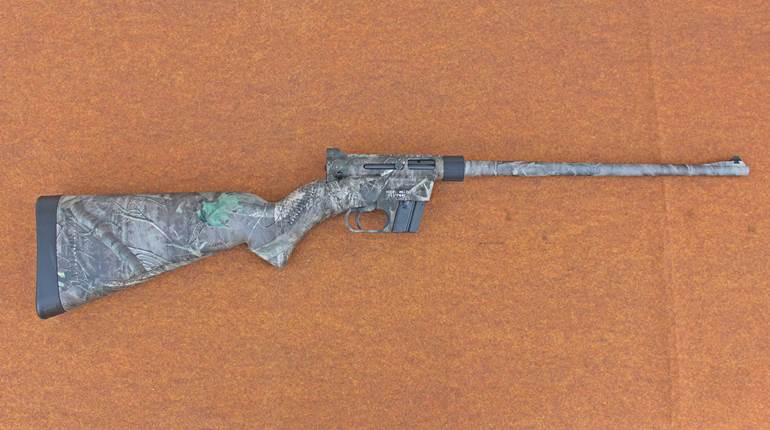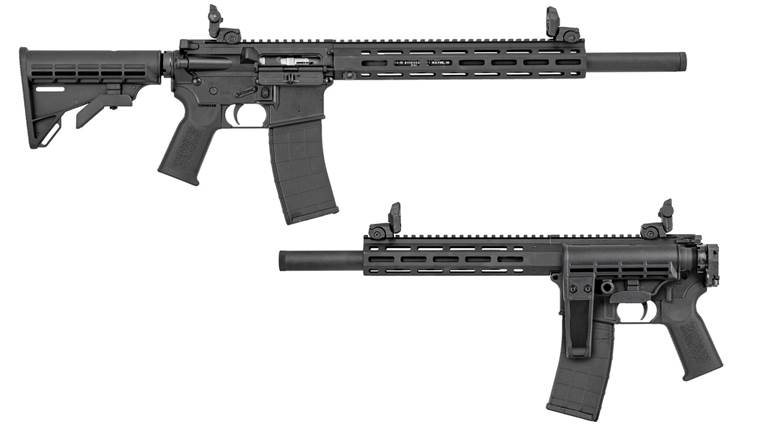
The three micro red-dots shown (clockwise from upper l.)—the Crimson Trace CTS-1250, Leupold DeltaPoint Pro and Trijicon RMR Type 2—are each built around a different mounting footprint than the others, but a system of adapter plates allows Springfield’s XD-M OSP pistols to mount any of the three.
Tubeless, reflex-style sights have come a long way since the cumbersome and unsophisticated early iterations of the mid-1980s—the first slide-mounted red-dot ever evaluated by this magazine had literally been epoxied atop the gun. Designs are now so lightweight and compact that they don’t impair the function of most contemporary autoloading pistols or lend the host gun a top-heavy center of balance, and modern innovations such as auto-on/auto-off capability, solar-powered battery back-up and the ability to self-regulate the intensity of the aiming point to best suit ambient lighting conditions have only added to their utility.
As a result, the integration of a micro red-dot (MRD) sight atop a pistol slide cut expressly for the use of such an accessory has been one of the most active trends in the firearm industry during the past few years. Today, essentially every major optics company already offers its own renditions of the former, while virtually every notable gunmaker is now in production of at least one (and in some cases dozens) of the latter. And for good reason, as an MRD aboard a handgun offers a bevy of practical benefits for both novice and expert shooters alike.
Docter—now owned by Noblex—created its own mounting footprint back in 1998, and today, more MRDs use it than any other pattern. Examples shown include the Noblex Sight II Plus (r.), along with (above, l. to r.) the Burris FastFire 3, Hex Dragonfly, Lucid Litl MO, Sightmark Mini Shot M-Spec and Vortex Venom.
Once thought of as a premium upgrade rarely encountered on real-world guns, an optic-cut slide has become such a standard feature these days that new pistol introductions without this ability are becoming conspicuous for its absence. In fact, far from requiring an exorbitant upcharge, pistol manufacturers have become so efficient at the process that most optics-ready (OR) models now cost only marginally more than their base designs—and even many budget-priced semi-automatics are currently offered in an MRD-compatible variant. As you’ll see in a moment, the list of available options on the market today includes multiple sub-$500 guns (look no further than p. 48 of this magazine for two great new examples from Taurus), and even a few quality options that can be had by the OR-curious gun buyer for less than $400.
However, a great deal of confusion has seeped into the modern optics-ready marketplace over the years, resulting in a quagmire of moving parts that, unfortunately, I believe dissuades many prospective buyers from taking the plunge. The purpose of this article is to shed some light on—and hopefully help demystify much of the uncertainty surrounding—this equally fun and advantageous segment of the firearm industry.
The premise is quite simple—or at least it should be: Two holes bored through the optic allow it to be affixed to the drilled and tapped OR slide by way of a pair of screws. A series of (either two or four) dimples in the flat bottom of the MRD line up with corresponding pegs in the top plane of the mounting surface of the gun to both help keep the red-dot secured in place and to arrest the recoil energy exerted on the optic by the sharp reciprocation of the slide. All of these holes, dimples and pegs must be properly aligned for a given optic and a given pistol to be used together. So far, so good.
But, as more and more MRDs and optics-ready pistols entered the marketplace, manufacturers began to experiment with the configuration of their products’ mounting interfaces. By altering the width of the gap between the screw holes and/or the orientation of the anchoring dimples, a number of distinct footprints were created that do not play well together. Suddenly, there was no guarantee that Optic A could be used atop Pistol B.
Gunmakers responded in two ways: by drilling their slides with more than one set of screw holes and/or by developing adapter plates configured to accept some of the more popular mounting footprints. Taken together, this allowed a particular OR pistol to play host to the MRDs of multiple patterns. But even today—with the abundance of optic-compatible pistols, pistol-compatible optics and adapter plates available for consumers to choose from—there is still no assurance that an MRD randomly pulled from the shelf will be able to mount onto the gun of your choice, so some forethought before making a purchase is greatly encouraged.
The mounting systems that optics-ready pistols use can vary greatly, but Smith & Wesson’s line of C.O.R.E. semi-automatics ship with seven plastic adapter plates and five different screw sets—in addition to the slide cap that is used when no optic is present.
With that in mind, and in an effort to provide prospective OR customers on either side of the pistol/optic equation with as much pre-purchase information as possible, I conducted a thorough survey of the current optics-ready landscape, contacting each company individually so as to get the information straight from the horses’ mouths. The results are presented below in the form of two tables. The first catalogs many of the optics industry’s currently available MRD models, as well as which mounting footprint each is built around. The second lists the optics-ready pistol models available on the firearm market today, along with details regarding the mounting system they employ and which optical footprints that system can accommodate.
As this important information regarding compatibility is sometimes not made readily accessible by the companies, I thought it would be valuable to compile it all in one place for easy reference by potential buyers. But first, a bit more explanation is necessary in order for all of what follows to make sense.
Much of the confusion surrounding OR guns and their optics stems from a total lack of standardization within both industries regarding the identification of the various mounting footprints—a situation that has created the false impression that many more patterns exist than actually do. For example, one company may tell you that its MRD uses the Burris FastFire footprint, while another lists on its website that its model is built around the Vortex Venom footprint. Well guess what? Both the Burris FastFire and the Vortex Venom employ the same footprint—and it was first developed by Docter back in 1998, so that company deserves the credit. I have found this phenomenon to be rampant within the optics industry, and it occurs on the gun side as well, serving to really muddy the waters for consumers.
However, once you realize that the vast majority of today’s micro red-dots use one of only four main mounting patterns—the C-More, Docter, RMR and Shield footprints—a great deal of the seeming complexity falls away. Of these, the Shield footprint came first, dating back to 1996, with Docter close on its heels in 1998. Trijicon then created its own pattern with the launch of the RMR in 2008, and C-More followed suit in 2009. You’ll note that I referred to the third one as the RMR footprint instead of the Trijicon footprint; this is an attempt to differentiate it from the Trijicon MRO footprint used by many larger, tube-style red-dots that are typically too heavy for use with a pistol and are therefore outside the scope of this article. Don’t get me wrong, there are certainly other “unique” mounting patterns out there beyond these four, but it is a rare occurrence that they are adopted by companies other than the ones that created them.
To be honest, after conducting the research needed for this article, I was a little surprised that more MRDs didn’t utilize the RMR footprint, given that Trijicon’s model has achieved a level of name recognition within the optics world that is just slightly less prevalent than famous generic trademarks like Winnebago, Xerox, Jacuzzi and Kleenex. People use the term “RMR” when they mean “MRD” all the time, and it was somewhat unexpected to see that the Docter (a well-regarded German company, purchased by Noblex a few years back, but one that is far less frequently encountered on this side of the pond) footprint is actually used by nearly double as many micro red-dot models.
Also adding to the confusion is the fact that I have found many optics manufacturers do a perplexingly shoddy job of providing prospective customers with their products’ footprint information. Some fail to convey this vital information anywhere on their websites or packaging—relegating it only to the product’s potentially-difficult-to-find owner’s manual. Would you ever consider buying a box of ammunition that didn’t divulge what chambering the cartridges inside were designed to fit?
Consumers should also be aware that the mounting systems employed by firearm makers can vary greatly. Many adapter plates are thin plastic and weigh virtually nothing, while others are metallic and can add ounces to the weight of the firearm. Some manufacturers provide a slew of plates with any optics-ready purchase. On the other hand, some include none, only making them available for separate aftermarket purchase. And some split the difference by coming with no plates in the box, but by providing a voucher that can be redeemed with the company for one free adapter of the owner’s choice—allowing shooters to mount the optic they may already have on hand while avoiding the clutter of superfluous plates. A few pistol models, typically subcompacts intended for concealed carry, even forgo the versatility of an adapter-plate system entirely and only allow the user to mount optics of a specific footprint directly to the slide.
I have attempted to convey all of this information in the below OR pistol table. Readers need to be aware, though, that in cases where multiple plates come with the gun, I have only listed those specific plates, even though additional patterns may very well be available on the aftermarket. Conversely, pistols that come with no plates will have all aftermarket plates offered by the firearm’s manufacturer listed, but again, still more third-party options not listed may exist.
Despite being similar in basic function, there is actually a decent amount of variation in MRDs from model to model in terms of shape, size and length. Although all are classified as “micro,” that term is relative, and some MRDs are much “micro-er” than others. This has essentially created what I consider to be two (very unofficial) classes of the optics—medium-size “tactical” reflex sights and truly miniscule “carry” MRDs.
While an optic’s footprint dictates its screw/dimple orientation, it does not necessarily have an impact on that accessory’s overall shape and length, and, as a result, there is unfortunately still no 100 percent certainty that a plate (or slide) cut to accept the optics of a particular footprint will be able to work with all of the options within that pattern. Guns that mount their optics (or plates) atop a flat top are unlikely to encounter any problems, but slides with a deeply recessed cut intended for use with “carry”-size sights may be unable to accommodate the larger “tactical” options within that footprint.
Leupold’s excellent DeltaPoint Pro provides a great example: Many of the smallest micro red-dots on the market employ the Shield footprint, but as a “tactical” MRD built on this pattern, the Leupold is too long for use aboard some Shield plates and slides cut specifically for smaller “carry” models. This is not a frequent occurrence, but it does happen. You may note in the following table that some pistols provide multiple adapter plates for a particular footprint; given the variance in micro red-dot size and shape, this is an effort to maximize the number of optics models compatible with their guns.
A potential issue to be aware of: “Tactical”-size MRDs, like Bushnell’s RXS-250 (above, l.) may be too long to fit within the slide cut of some guns, while the “carry”-size Riton MPRD (above, r.) fits well.
Also, because the heights of their housings can differ quite substantially, even within a given footprint, the length of the screws needed to secure an MRD to the gun may also vary. Many OR pistols come with multiple sets of screws for this reason—S&W C.O.R.E. models, for example, come with five sets. Potentially confusing the situation even further: Many pistols use a single set of screws to secure the optic to the gun, with the plate sandwiched between them, but some utilize two sets of screws, one to secure the MRD to the adapter and another to secure the adapter to the firearm. And while it has been my experience that it is usually the gun side of the pairing that supplies the screws, which makes sense as it’s the thread specification of the holes tapped into the slide that determines what diameter and pitch of fastener is needed, a number of optics also include their own.
Be warned, however, that not all OR pistols come with an assortment of screw sets (some may only come with one, intended for use with a single MRD model within the footprint), so maintaining a store of extra screws is a wise practice. Someone with multiple optics-ready pistols and multiple micro red-dots may want to consider purchasing something like Swampfox Optics’ Ultimate Red Dot Screw Pack ($20), a bundle that includes 14 four-screw sets of various thread pitches and lengths. Not only would this help ensure that all of your various setups are good to go, but it would also mean that spares are available for when one of those tiny suckers inevitably goes flying into the ether.
A number of optics-ready pistols feature “suppressor-height” iron sights, others do not. Some mounting systems even replace the rear sight fixture entirely, meaning that, should the battery die, the user will have little choice but to resort to point shooting. Just be aware that, due to the varying shapes and sizes in irons, MRDs and slide cuts, the presence of raised sights does not necessarily guarantee the ability of the irons to be co-witnessed with the reticle of all optics. There’s a strong likelihood that they will be compatible, and some optics even have a trough molded into them to help facilitate this, but a few red-dot housings are so tall as to spoil proper alignment of the elements.
Also, consider that a small but growing subset within the optics-ready-pistol market are optics-included models that ship from the factory with the MRD already installed (or at least with it in the box to save battery life)—and possibly with its aiming point even already regulated for use at a specific distance. Of course, purchasing a gun/optic combo in this way removes all guesswork from the equation, however, should the owner later desire to switch to another red-dot, units within the same footprint will generally interchange, and alternate plates may also still be available that will allow for the installation of other footprints as well.
I also need to make special mention of two manufacturers, FN and SIG Sauer, as the complexity of their optical systems defies adequate explanation through a simple table. The rest of the lists should be fairly self-explanatory. The Low Profile Optics Mounting System used by the various optics-ready variants of the FN 509 includes a total of four metal “MRD Plates,” three plastic “MRD Inserts” and six sets of screws. Ingenious but a bit complex at first, these components can be re-arranged into too many configurations to list here, but suffice it to say that the guns can accommodate a great many micro red-dot models—including examples from all four major footprints.
(l-r) The C-More Footprint (Vortex Razor), The Docter Footprint (Burris FastFire 3), The RMR Footprint (Trijicon RMR Type 2), The Shield Footprint (Leupold DeltaPoint Pro)
SIG’s system is even more difficult for the uninitiated to intuit, as the company has developed not one, but five, unique mounting footprints—with very little intermingling of optics and guns possible between them. The RomeoZero red-dot uses the common Shield footprint, but the rest of the company’s MRDs all employ one of these five unique patterns. And, while the MAX and XL variants of the Romeo3 share the same footprint, the rest of SIG’s models (including the standard Romeo3) all employ different patterns from each other. The Romeo1Pro and Romeo2 optics use two differently modified Shield footprints, however, so each may be compatible with some Shield mounts.
On the firearm side of things, all optics-ready SIG pistols are cut to mount optics directly to the slide without mounting plates. Guns with an SKU suffix that includes “RX” are compatible with the Romeo1, while guns with an SKU suffix that includes either “RXP” or “R2” are compatible with both the Romeo1Pro and the Romeo2. Due to a design revision, depending on the time of production, some optics-ready P320 slides are also RMR-compatible. Meanwhile, the P365X and P365XL are cut for use with the RomeoZero—with some optics-included models available—and the P320MAX ships with a Romeo3MAX.
And lastly, before we get to the tables, one final caveat emptor is in order. These lists are intended to serve only as a starting point for potential buyers, as a general resource of what footprints various optics use and what plates come with currently available OR pistols. If you’ve been paying attention up to this point, you’ll realize that (due to the variances in MRD, adapter plate and slide-cut shape) I cannot state with unequivocal certainty that a given gun will be compatible with a given sight—even if both are of the same mounting footprint—so a quick double-check with both of your possible setup’s manufacturers is still advisable. They likely will be in most cases—assuming that you’re not trying to fit a “tactical” peg into a “carry” hole—but buyer beware, nonetheless.
Of course, while I attempted to be as comprehensive as possible with these lists, it is certainly quite possible that I missed a few manufacturers while compiling things, so apologies if any micro red-dots or optics-ready pistol models were omitted. A few companies neglected to respond to numerous requests for information, which may explain their absence. And, with MRD models constantly being re-designed, added to and dropped from the market, this compiled information offers, at best, a snapshot in time. With that in mind, models that I know to have been discontinued, such as the Nikon Spur and Redfield Accelerator, have been omitted, as are units that are rated for rifle use only.
Micro red-dots offer significantly quicker target acquisition than iron sights for most users. I have also yet to encounter the handgun shooter who can group better at 25 yards without one than with it—and despite their diminutive size, they can actually be among the most durable and recoil-proof optics available today. It is a great shame that the perplexing state of the OR market at present seems to be acting as a barrier to entry for curious newcomers, and I sincerely hope you find this information to be useful and that it dispels any hesitancy you may be experiencing regarding optics-ready pistols. Happy shopping, everyone!

Download Print-Friendly PDF Chart No. 1
Download Print-Friendly PDF Chart No. 2














